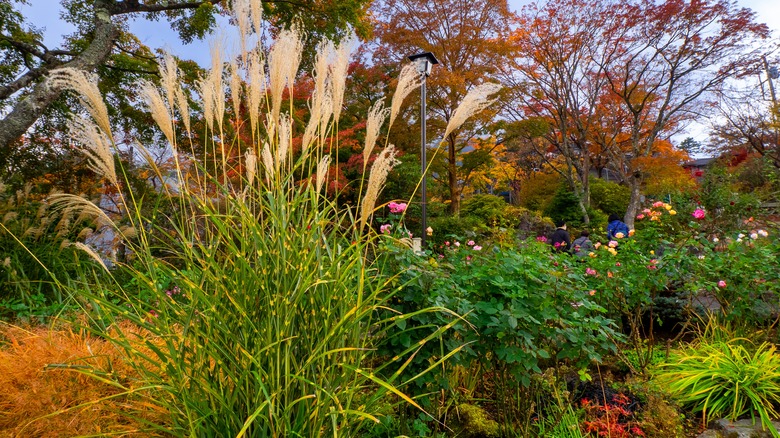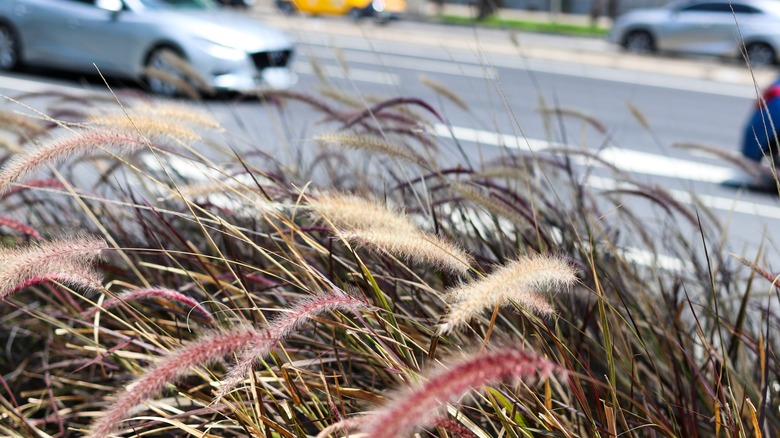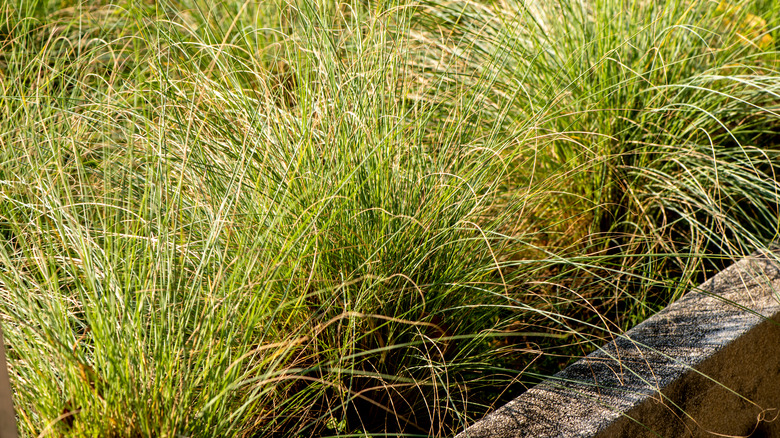Alternatives To Consider For Invasive Maiden Silvergrass In The Garden
Ornamental grasses (as opposed to the grass your lawn is made of) are popular decorative plants for home gardens and property borders. They're easy to care for and provide height, contrast, and color in landscaping. Silvergrass (Miscanthus sinensis) — also known as zebra grass, porcupine grass, maiden grass, Chinese silvergrass, Japanese silvergrass, susuki, Eulalia, and a clump of other common names — is one such grass. Despite its popularity, it's problematic, having been deemed invasive in many parts of the United States. If you're looking to dig up and dispose of your beds of silvergrass, some of the perfect ornamental grasses for your yard include big and little bluestem, Indian grass, switchgrass, purple lovegrass, and prairie dropseed. Bonus: they're all native grasses!
Silvergrass is native to East Asia and grows naturally in countries from Russia to Japan. The plant found its way into American gardens in the 1800s, introduced because of its pretty fall and winter colors, tall-wide profile, and hardiness. So it's had a lot of time to escape the confines of our yard and establish itself in the wild. And therein lies the problem. The grass spreads rapidly by seed and rhizome, populating disturbed areas like roadsides and existing grasslands where it crowds out local plants. It's highly flammable, feeding flames in regions prone to forest fires, but can survive the fire itself. It also doesn't support wildlife, unlike native grasses. These are just some of the reasons you'll want to replace it.
A pest at best
Today, silvergrass species and their many cultivars — over 100 and counting — are still being sold in nurseries across the U.S. This is despite the plant's aforementioned invasive status in many states. Some organizations are taking a stand against the plant. To determine the invasiveness potential of silvergrass, researchers working with the Chicago Botanic Gardens studied the seed-setting capabilities of various cultivars over five years. There was a shocking 60%-plus survival rate, representing "a high risk for self-seeding," as outlined in the 2012 Journal of Environmental Horticulture-published paper. Following the study's release, the Gardens removed all their silvergrass stands because they didn't "want to send a mixed message to visitors," a representative said to the Chicago Tribune in 2017.
One solution often proposed online is to plant non-spreading or so-called sterile silvergrass cultivars like "Morning Light," "Flamingo," "Ghana," or "Adagio." However, these plants still flower, and if they cross-breed with other fertile cultivars, the resulting hybrids may create seeds that can germinate. To avoid cross-pollination, stick to planting a single stand of silvergrass — though a 2016 study of wild Amur silvergrass (Miscanthus sacchariflorus) populations in Iowa and Minnesota published in Invasive Plant Science and Management found cross-pollination still occurred between the Amur silvergrass and nearby (but not close) Chinese silvergrass stands.
What to plant instead
The better solution is to replace silvergrass with native ornamental grasses that thrive with little water or care. Silvegrass is well-liked for several reasons: it grows tall (up to 12 feet), making it an excellent privacy plant; it's densely bunched, getting 5 feet broad; the various cultivars boast attractive leaf patterns — from silver-tinged to zebra-striped; and the flowers in late summer add subtle creams and pinks to the garden. It also tolerates most soil types, light shade, and frosts, and its seeds feed songbirds.
Switchgrass (Panicum virgatum) is an oft-recommended substitute. This native prairie tallgrass forms attractive clumps, has pretty mauve seed heads, and reaches 6 feet. It, too, has many cultivars, such as the epically tall Cloud Nine or the soft-blue-leaved "Cape Breeze." For gardeners in the midwestern and eastern states, switchgrass is also a host plant for the Delaware skipper butterfly. Little and big bluestem grasses (Andropogon gerardii and Schizachyrium scoparium, respectively) are two other popular alternatives. They both have namesake blue-green leaves in spring that turn bronze in colder months. They're deep-rooted, helping reduce soil erosion, and birds love their seeds.
Other options recommended by various government agencies and universities include the North American native grasses Northern sea oats (Chasmanthium latifolium) and ribbon grass (Phalaris arundinacea var. picta); prairie dropseed (Sporobolus heterolepis) — for structure in the garden; border plant Purple lovegrass (Eragrostis spectabilis); and blue-green to golden-leaved Indian grass (Sorghastrum nutans), though it can become invasive if care isn't taken.


